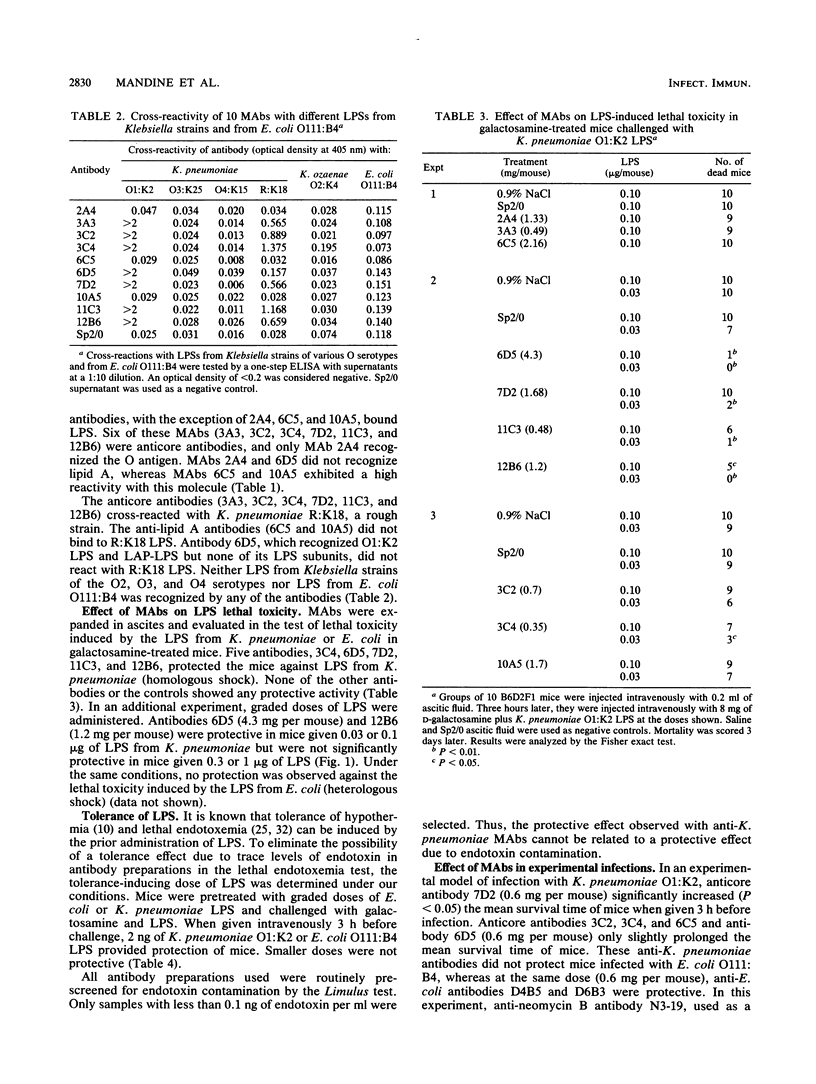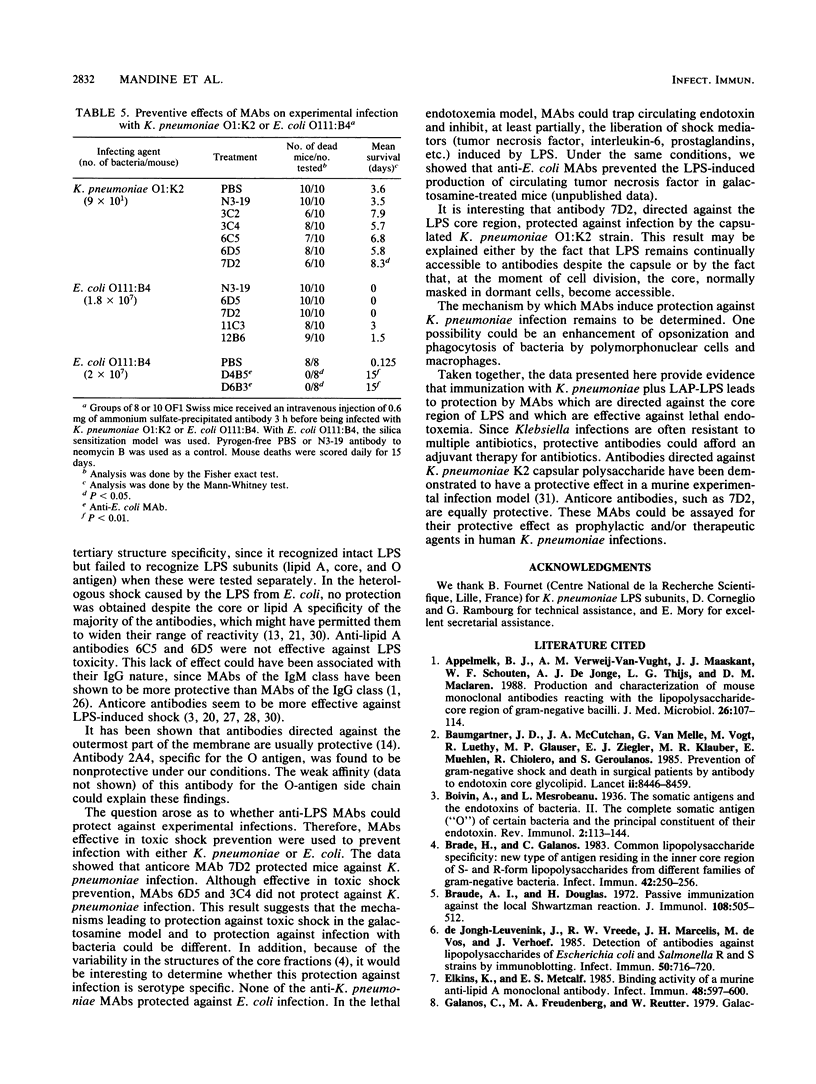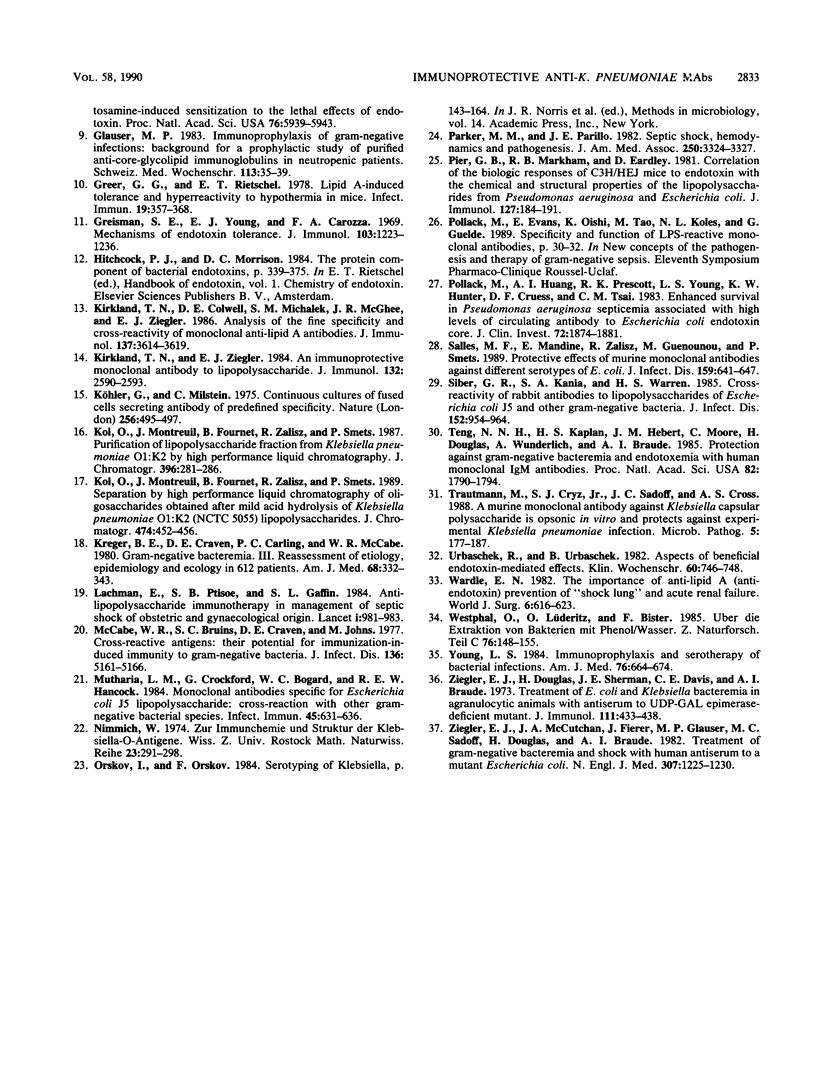Abstract
To prepare monoclonal antibodies (MAbs) directed against the core-lipid A fractions of smooth lipopoly-saccharide (LPS) from Klebsiella pneumoniae O1:K2, we immunized BALB/c mice with the LPS-associated proteins plus LPS. This preparation exposed the core-lipid A moiety, which is normally hidden in the micellar structure of classical LPS preparations. Among 10 MAbs selected for their reactivity with LPS-associated proteins plus LPS from K. pneumoniae O1:K2, 6 (3A3, 3C2, 3C4, 7D2, 11C3, and 12B6) were directed against the core fraction and 2 (6C5 and 10A5) were directed against the lipid A fraction. Only one (2A4) recognized the O antigen, and one (6D5) had an undefined specificity. When injected before challenge with K. pneumoniae O1:K2 LPS in galactosamine-sensitized mice, five of the MAbs (3C4, 6D5, 7D2, 11C3, and 12B6) provided protection in this model of lethal endotoxemia. MAb 7D2 was also protective in an experimental infection with capsulated K. pneumoniae O1:K2.
Full text
PDF





Selected References
These references are in PubMed. This may not be the complete list of references from this article.
- Appelmelk B. J., Verweij-van Vught A. M., Maaskant J. J., Schouten W. F., De Jonge A. J., Thijs L. G., Maclaren D. M. Production and characterisation of mouse monoclonal antibodies reacting with the lipopolysaccharide core region of gram-negative bacilli. J Med Microbiol. 1988 Jun;26(2):107–114. doi: 10.1099/00222615-26-2-107. [DOI] [PubMed] [Google Scholar]
- Brade H., Galanos C. Common lipopolysaccharide specificity: new type of antigen residing in the inner core region of S- and R-form lipopolysaccharides from different families of gram-negative bacteria. Infect Immun. 1983 Oct;42(1):250–256. doi: 10.1128/iai.42.1.250-256.1983. [DOI] [PMC free article] [PubMed] [Google Scholar]
- Braude A. I., Douglas H. Passive immunization against the local Shwartzman reaction. J Immunol. 1972 Feb;108(2):505–512. [PubMed] [Google Scholar]
- Elkins K., Metcalf E. S. Binding activity of a murine anti-lipid A monoclonal antibody. Infect Immun. 1985 May;48(2):597–600. doi: 10.1128/iai.48.2.597-600.1985. [DOI] [PMC free article] [PubMed] [Google Scholar]
- Galanos C., Freudenberg M. A., Reutter W. Galactosamine-induced sensitization to the lethal effects of endotoxin. Proc Natl Acad Sci U S A. 1979 Nov;76(11):5939–5943. doi: 10.1073/pnas.76.11.5939. [DOI] [PMC free article] [PubMed] [Google Scholar]
- Glauser M. P. Immunoprophylaxis of gram-negative infections: background for a prophylactic study of purified anticore-glycolipid immunoglobulins in neutropenic patients. Schweiz Med Wochenschr Suppl. 1983;14:35–39. [PubMed] [Google Scholar]
- Greer G. G., Rietschel E. T. Lipid A-induced tolerance and hyperreactivity to hypothermia in mice. Infect Immun. 1978 Feb;19(2):357–368. doi: 10.1128/iai.19.2.357-368.1978. [DOI] [PMC free article] [PubMed] [Google Scholar]
- Greisman S. E., Young E. J., Carozza F. A., Jr Mechanisms of endotoxin tolerance. V. Specificity of the early and late phases of pyrogenic tolerance. J Immunol. 1969 Dec;103(6):1223–1236. [PubMed] [Google Scholar]
- Kirkland T. N., Colwell D. E., Michalek S. M., McGhee J. R., Ziegler E. J. Analysis of the fine specificity and cross-reactivity of monoclonal anti-lipid A antibodies. J Immunol. 1986 Dec 1;137(11):3614–3619. [PubMed] [Google Scholar]
- Kirkland T. N., Ziegler E. J. An immunoprotective monoclonal antibody to lipopolysaccharide. J Immunol. 1984 May;132(5):2590–2592. [PubMed] [Google Scholar]
- Kol O., Montreuil J., Fournet B., Zalisz R., Smets P. Purification of the lipopolysaccharide fraction from Klebsiella pneumoniae O1 K2 by high-performance liquid chromatography. J Chromatogr. 1987 Jun 19;396:281–286. doi: 10.1016/s0021-9673(01)94065-8. [DOI] [PubMed] [Google Scholar]
- Kol O., Montreuil J., Fournet B., Zalisz R., Smets P. Separation by high-performance liquid chromatography of oligosaccharides obtained after mild acid hydrolysis of Klebsiella pneumoniae O1K2 (NCTC 5055) lipopolysaccharides. J Chromatogr. 1989 Jul 19;474(2):452–456. doi: 10.1016/s0021-9673(01)93943-3. [DOI] [PubMed] [Google Scholar]
- Kreger B. E., Craven D. E., Carling P. C., McCabe W. R. Gram-negative bacteremia. III. Reassessment of etiology, epidemiology and ecology in 612 patients. Am J Med. 1980 Mar;68(3):332–343. doi: 10.1016/0002-9343(80)90101-1. [DOI] [PubMed] [Google Scholar]
- Köhler G., Milstein C. Continuous cultures of fused cells secreting antibody of predefined specificity. Nature. 1975 Aug 7;256(5517):495–497. doi: 10.1038/256495a0. [DOI] [PubMed] [Google Scholar]
- Lachman E., Pitsoe S. B., Gaffin S. L. Anti-lipopolysaccharide immunotherapy in management of septic shock of obstetric and gynaecological origin. Lancet. 1984 May 5;1(8384):981–983. doi: 10.1016/s0140-6736(84)92324-9. [DOI] [PubMed] [Google Scholar]
- Mutharia L. M., Crockford G., Bogard W. C., Jr, Hancock R. E. Monoclonal antibodies specific for Escherichia coli J5 lipopolysaccharide: cross-reaction with other gram-negative bacterial species. Infect Immun. 1984 Sep;45(3):631–636. doi: 10.1128/iai.45.3.631-636.1984. [DOI] [PMC free article] [PubMed] [Google Scholar]
- Parker M. M., Parrillo J. E. Septic shock. Hemodynamics and pathogenesis. JAMA. 1983 Dec 23;250(24):3324–3327. [PubMed] [Google Scholar]
- Pier G. B., Markham R. B., Eardley D. Correlation of the biologic responses of C3H/HEJ mice to endotoxin with the chemical and structural properties of the lipopolysaccharides from Pseudomonas aeruginosa and Escherichia coli. J Immunol. 1981 Jul;127(1):184–191. [PubMed] [Google Scholar]
- Pollack M., Huang A. I., Prescott R. K., Young L. S., Hunter K. W., Cruess D. F., Tsai C. M. Enhanced survival in Pseudomonas aeruginosa septicemia associated with high levels of circulating antibody to Escherichia coli endotoxin core. J Clin Invest. 1983 Dec;72(6):1874–1881. doi: 10.1172/JCI111150. [DOI] [PMC free article] [PubMed] [Google Scholar]
- Salles M. F., Mandine E., Zalisz R., Guenounou M., Smets P. Protective effects of murine monoclonal antibodies in experimental septicemia: E. coli antibodies protect against different serotypes of E. coli. J Infect Dis. 1989 Apr;159(4):641–647. doi: 10.1093/infdis/159.4.641. [DOI] [PubMed] [Google Scholar]
- Siber G. R., Kania S. A., Warren H. S. Cross-reactivity of rabbit antibodies to lipopolysaccharides of Escherichia coli J5 and other gram-negative bacteria. J Infect Dis. 1985 Nov;152(5):954–964. doi: 10.1093/infdis/152.5.954. [DOI] [PubMed] [Google Scholar]
- Teng N. N., Kaplan H. S., Hebert J. M., Moore C., Douglas H., Wunderlich A., Braude A. I. Protection against gram-negative bacteremia and endotoxemia with human monoclonal IgM antibodies. Proc Natl Acad Sci U S A. 1985 Mar;82(6):1790–1794. doi: 10.1073/pnas.82.6.1790. [DOI] [PMC free article] [PubMed] [Google Scholar]
- Trautmann M., Cryz S. J., Jr, Sadoff J. C., Cross A. S. A murine monoclonal antibody against Klebsiella capsular polysaccharide is opsonic in vitro and protects against experimental Klebsiella pneumoniae infection. Microb Pathog. 1988 Sep;5(3):177–187. doi: 10.1016/0882-4010(88)90020-4. [DOI] [PubMed] [Google Scholar]
- Urbaschek R., Urbaschek B. Aspects of beneficial endotoxin-mediated effects. Klin Wochenschr. 1982 Jul 15;60(14):746–748. doi: 10.1007/BF01716569. [DOI] [PubMed] [Google Scholar]
- Wardle E. N. The importance of anti-lipid A (anti-endotoxin): prevention of "shock lung" and acute renal failure. World J Surg. 1982 Sep;6(5):616–623. doi: 10.1007/BF01657880. [DOI] [PubMed] [Google Scholar]
- Young L. S. Symposium on infectious complications of neoplastic disease (Part II). Immunoprophylaxis and serotherapy of bacterial infections. Am J Med. 1984 Apr;76(4):664–671. doi: 10.1016/0002-9343(84)90292-4. [DOI] [PubMed] [Google Scholar]
- Ziegler E. J., Douglas H., Sherman J. E., Davis C. E., Braude A. I. Treatment of E. coli and klebsiella bacteremia in agranulocytic animals with antiserum to a UDP-gal epimerase-deficient mutant. J Immunol. 1973 Aug;111(2):433–438. [PubMed] [Google Scholar]
- Ziegler E. J., McCutchan J. A., Fierer J., Glauser M. P., Sadoff J. C., Douglas H., Braude A. I. Treatment of gram-negative bacteremia and shock with human antiserum to a mutant Escherichia coli. N Engl J Med. 1982 Nov 11;307(20):1225–1230. doi: 10.1056/NEJM198211113072001. [DOI] [PubMed] [Google Scholar]
- de Jongh-Leuvenink J., Vreede R. W., Marcelis J. H., de Vos M., Verhoef J. Detection of antibodies against lipopolysaccharides of Escherichia coli and Salmonella R and S strains by immunoblotting. Infect Immun. 1985 Dec;50(3):716–720. doi: 10.1128/iai.50.3.716-720.1985. [DOI] [PMC free article] [PubMed] [Google Scholar]


